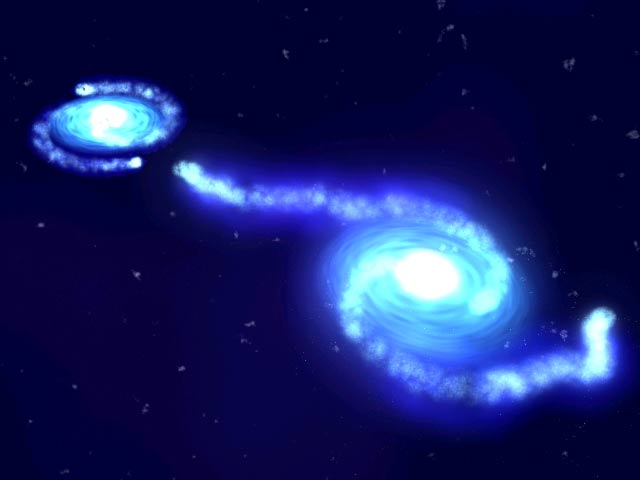Collisions Fuel Black Hole Feeding Frenzies

Black hole feeding frenzies are fueled by galacticcollisions, suggests a new study that confirms astronomers' suspicions.
Astronomers have had their eyes on a certain class ofgalaxies that appear to contain central black holes that gorge on gas and dust.So far, scientists have been unsure what triggers these giant meals, but newradio observations may help explain how they work.
Seyfert galaxies are a type of galaxy known as ActiveGalactic Nuclei (AGN), thought to host supermassive black holes in theircenters. Seyferts are slightly tamer versions of the extremely luminous AGNcalled quasarsand blazars.
Scientists guessed that recent interactionswith neighboring galaxies might have stirred up Seyferts' gas and dust andpropelled it toward their giant black holes. But when optical telescopesobserve Seyferts in light visible to the human eye, the Seyferts show no signof close encounters with other galaxies.
Now astronomers have used the Very Large Array (VLA)telescope to photograph these objects in radio light, and found that the majorityof Seyferts do indeed seem to have recently collided with a neighbor. For comparison, theresearchers observed non-Seyfert galaxies and found that very few showed signsof an interaction.
"This comparison clearly shows a connection betweenclose galactic encounters and the black-hole-powered activity in thecores," said Ya-Wen Tang, who began this work at the Institute ofAstronomy & Astrophysics, Academia Sinica (ASIAA), in Taiwan and now is agraduate student at the National Taiwan University. "This is the best evidenceyet for the fueling of Seyfert galaxies. Other mechanisms have been proposed,but they have shown little if any difference between Seyferts and inactivegalaxies."
The VLA telescope was able to study the galaxies' hydrogengas by observing the radio waves emitted by hydrogen atoms. The hydrogen gas inmany Seyferts left a clear signal of being disturbed by a collision withanother galaxy.
Breaking space news, the latest updates on rocket launches, skywatching events and more!
"Our results show that images of the hydrogen gas are apowerful tool for revealing otherwise-invisible gravitational interactionsamong galaxies," said Jeremy Lim, also of ASIAA. "This is a welcomeadvance in our understanding of these objects, made possible by the best andmost extensive survey ever made of hydrogen in Seyferts."
The new study helps scientists better understand theseviolent systems, where gas and dust swirl around dense black holes thateventually gobble up the incoming material.
"The VLA lifted the veil on what's really happeningwith these galaxies," said Cheng-Yu Kuo, a graduate student at theUniversity of Virginia. "Looking at the gas in these galaxies clearlyshowed that they are snackingon their neighbors. This is a dramatic contrast with their appearance invisible starlight."
- VIDEO: Black Hole Blazar Jets
- VIDEO: Black Holes - Warpers of Time and Space
- All About Black Holes

Clara Moskowitz is a science and space writer who joined the Space.com team in 2008 and served as Assistant Managing Editor from 2011 to 2013. Clara has a bachelor's degree in astronomy and physics from Wesleyan University, and a graduate certificate in science writing from the University of California, Santa Cruz. She covers everything from astronomy to human spaceflight and once aced a NASTAR suborbital spaceflight training program for space missions. Clara is currently Associate Editor of Scientific American. To see her latest project is, follow Clara on Twitter.
